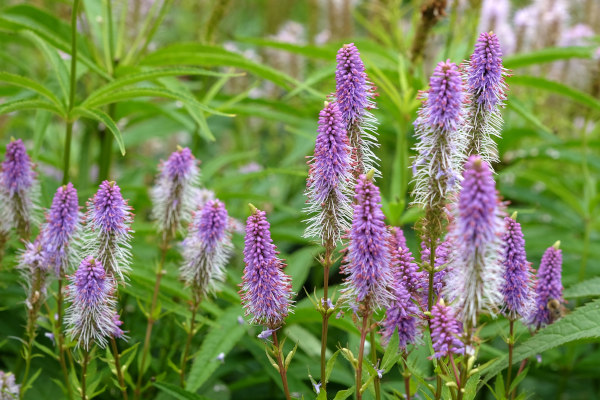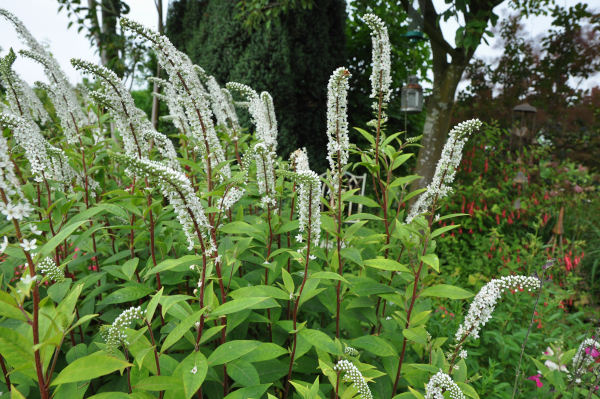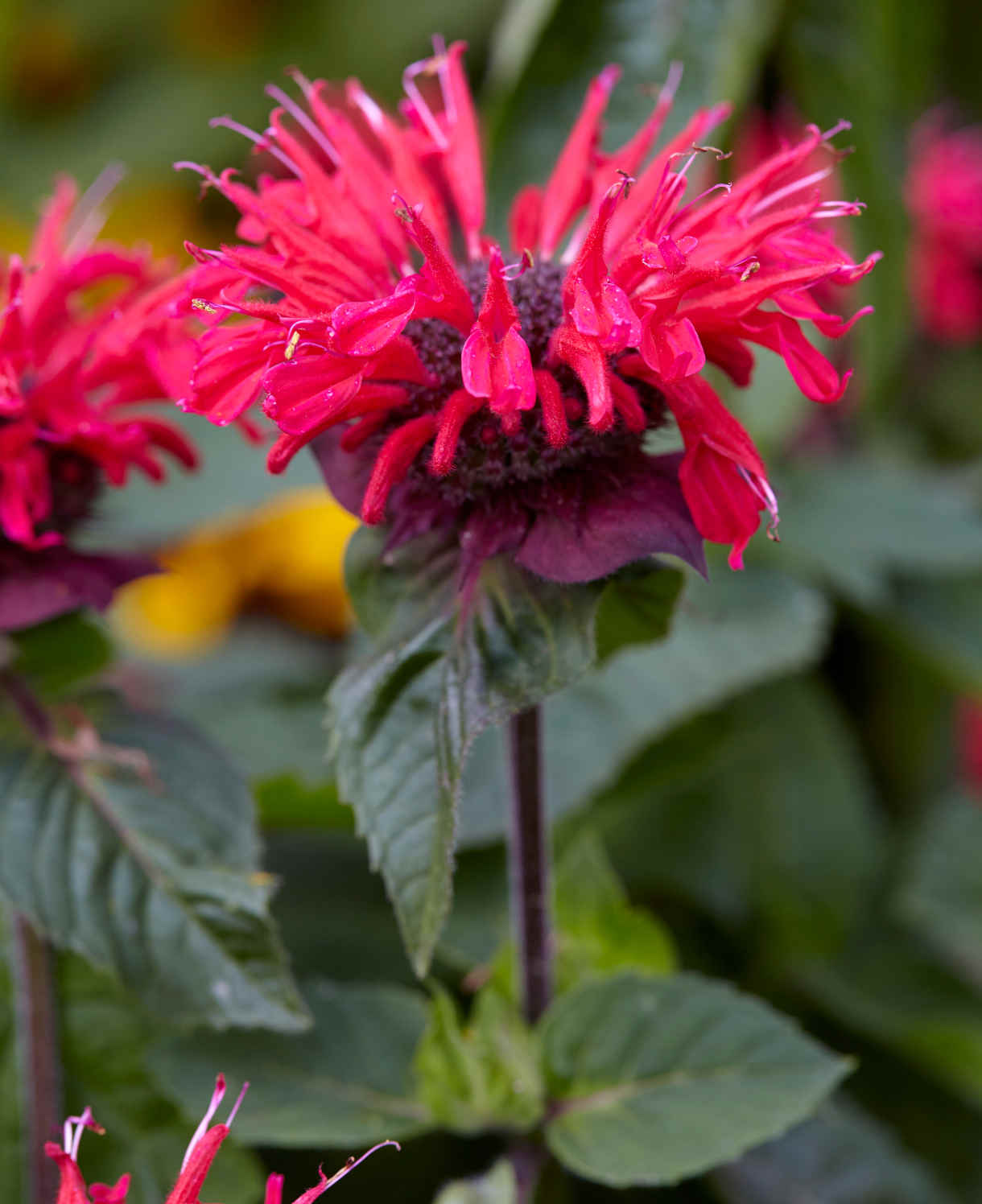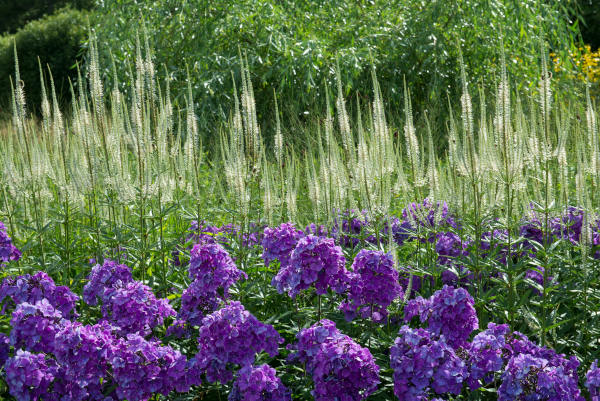How to grow Veronicastrum
As part of the Plaintain family, Veronicastrum is a tall, striking and elegant flower with plenty of foliage interest and vibrant colours. The most commonly cultivated species is Veronicastrum virginicum, which is native to North America.
Also known as Culver’s Root, this herbaceous perennial is an easy-going plant to grow and ideal for flower beds and the backs of borders. Veronicastrum’s tall leafy green stems carry dense clusters of small flowers. Veronicastrum cultivars are found in white, pink, purple and blue to add a pop of colour to your garden, while their flowers attract pollinators such as bees and butterflies.
Naturally pest-resistant, Veronicastrum grows to heights of 120cm and around 40cm in spread and takes 2-5 years to fully mature. Furthermore, continual deadheading will encourage further blooms throughout the seasons. A true sun-lover, Veronicastrum thrives in brighter areas of the garden and enjoys well-draining soil.
Ready to add some elegant structure to your garden bed or border? Discover everything there is to know about Veronicastrum below...

Key Information
Soil pH
Position
Hardiness


Where & when to plant Veronicastrum
The wildflower Veronicastrum are found growing in a wide range of environments, from wooded areas to open meadows, on river banks or in thickets, and will happily tolerate most soil conditions.
While Veronicastrum can grow in shade, the plant is prone to wilting in areas with extended shade. If you do not have somewhere to plant Veronicastrum that is in full sun, plant in an area with at least 4 hours of sunlight a day.
How to plant Veronicastrum
- For planting in the garden, dig the soil area removing any large stones and weeds and breaking up any lumps. Mix in some organic matter such as manure or garden compost. Rake level and firm with your heels. Rake level again.
- Water plants well and allow to drain before planting.
- A good tip is to dig a hole twice the size of the root-ball. Fill with water and allow to drain before placing in the plant.
- Place the plant in the hole, ensuring the top of the root ball sits level with the surface of the soil. Too low and the plant may rot, too high and the roots can dry out.
- Backfill with soil and firm in gently with your foot.
- Soak well with water.
- Mulch around the base with well-rotted organic matter.

What to plant with Veronicastrum
As prairie-style plants, Veronicastrum works well with tall grasses and other perennials. Calamagrostis x acutiflora is a good choice as it grows tall and provides movement and a backdrop for your colourful Veronicastrum. For companion perennials, Rudbeckias are a great pick with a prominently raised disk and vibrant yellow flora, Monarda also make wonderful companions, introducing unusual rounded flower shape.



How to care for Veronicastrum
Pruning & Deadheading
To extend the blooming period, deadhead Veronicastrum frequently. Also cut back to ground level when flowering has finished to encourage a possible, second flowering.
Watering
Veronicastrum enjoys moist, well-draining soil. During the growth phase, water regularly. Once established, water once a week and try not to let the soil dry out.
Cold Protection
Cut back Veronicastrum’s flower stalks in the autumn to prepare for the winter dormancy. Do this before the frost hits and you will see new healthy growth in the following spring. You do not need to mulch or further treat Veronicastrum as it is fully frost-hardy and can tolerate temperatures as low as -20°C.
Pests & Diseases
Veronicastrum is generally a pest-resistant plant. However, you should look out for diseases such as black leaf spots or downy mildew. As with all perennials, root rot can cause issues, so make sure that your soil drains well and that the roots are not left in standing water.
How to propagate Veronicastrum
The best way to propagate Veronicastrum is by division. Do this either in the autumn (before cutting back) or in the early spring after the last frost
Select a parent plant to take divisions from which is healthy, disease-free and grows well. Dig up its roots and use clean scissors or a knife to pry away some of the roots. Make sure that each root section has a bud when cutting and do not remove more than ⅓ of the parent plant’s roots. Once you have taken divisions, replant the parent plant as soon as possible
Fill 7-9cm pots with soil and add one root cutting to each pot. Settle the soil and plant in place by watering in. Put the pots in a sheltered position with plenty of warmth away from direct sunlight and water regularly to encourage healthy growth
When your plants are ready, they can be planted outdoors in their permanent positions; remember that Veronicastrum needs 4-8 hours of sunlight per day
Common Veronicastrum questions
Do you cut back Veronicastrum?
Yes, cut back Veronicastrum to around 5cm above ground level in late autumn. It is fully hardy so will come back in the spring.
Will Veronicastrum grow in shade?
While Veronicastrum can grow in shade, the plant is prone to wilting in areas with extended shade. If you do not have somewhere to plant Veronicastrum that is in full sun, plant in an area with at least 4 hours of sunlight a day - this will provide partial sun and partial shade.
Is Veronicastrum hardy?
Veronicastrum is a fully hardy perennial that can cope in temperatures as low as -20°C.
What is the difference between Veronica and Veronicastrum?
While being quite similar, there are a couple of differences. The leaves of Veronicastrum grow in whorls where Veronica have leaves which are opposite. Also the flowers of Veronicastrum have tubes longer than the lobes and Veronica has the lobes longer than the tubes.





